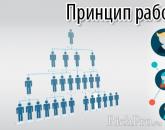Methodical materials for the lesson of geography. Occurrence of rocks
To view a presentation with pictures, design, and slides, download its file and open it in PowerPoint on your computer.
Text content of presentation slides: SIMULATOR TEMPLATE DMITRY IVANOV Start the test DalnerechenskPrimorsky Territory TEST RESULT Correct: 5Errors: 0Mark: 5 Time: 0 min. 29 sec. more fix SIMULATOR TEMPLATE DMITRY IVANOV During the excursion, the students made a schematic sketch of the occurrence rocks on a career break. sand-clay-limestone limestone-clay-sand clay-sand-limestone Indicate the sequence of occurrence of rocks in order of increasing age (from youngest to oldest). During the excursion, the students made a schematic sketch of the occurrence of rocks on a cliff in a quarry. clay-sand-dolomite-quartzite quartzite-dolomite-sand-clay clay-dolomite-sand-quartzite Indicate the sequence of occurrence of rocks in order of increasing age (from youngest to oldest). During the excursion, the students made a schematic sketch of the occurrence of rocks on a cliff in a quarry. black clay-loam-limestone loam-black clay-limestone loam-limestone-black clay limestone-loam-black clay Indicate the sequence of occurrence of rocks in order of increasing age (from youngest to oldest). During the excursion, the students made a schematic sketch of the occurrence of rocks on a cliff in a quarry. loam-sand-clay-sandstone sandstone-sand-clay-loam sandstone-clay-sand-loam Indicate the sequence of occurrence of rocks in order of increasing age (from youngest to oldest). Indicate the sequence of occurrence of rocks in order of increasing age (from youngest to oldest). During the excursion, the students made a schematic sketch of the occurrence of rocks on a cliff in a quarry. loam-with boulders-clay-sand sand-loam with boulders-clay sand-clay-loam with boulders
Attached files
Entrance test in geography Grade 7 with answers. The test includes 2 options. Each option has 11 tasks.
Option 1
1. Determine on the map the distance on the ground in a straight line from the spring to the well. Round the result to the nearest tens of meters. Write your answer in numbers.
2. Determine on the map in which direction the spring is located from the well.
3.
1) 1:100 000
2) 1:500 000
3) 1:50 000
4) 1:20 000
4. During the excursion, the students made a schematic sketch of the occurrence of rocks on a cliff in a quarry.

Arrange the rock layers shown in the figure in order increase their age (from youngest to oldest).
Write down the numbers that represent the rock layers in the correct sequence.
1) limestone
2) loam with boulders
3) quartzite
5. Using an atlas, determine which of the listed countries tsunamis pose the greatest danger.
1) Bolivia
2) Mongolia
3) Finland
4) Japan
6. Continent washed by the waters of 4 oceans
1) Eurasia
2) North America
3) Africa
4) South America
7. inland sea
1) Arabian
2) Black
3) Beringovo
4) Kara
8. Set match:
1) Earth's crust
2) Mantle
3) Core
A) Thickness from 5 to 80 km
B) The main element of the composition is iron
C) Thickness up to about 2900 km
9. Set match:
1) a recess in which water flows
2) the area from which water flows into the river
3) main river with all tributaries
4) the beginning of the river
A) swimming pool
B) channel
B) source
D) river system
10. Determine which of the points with the following geographical coordinates is located on the island?
1) 48°N 52°E
2) 40°N 44° E
3) 52°N 36°E
4) 16° S 48°W
11. In December 2006, off the coast of the island of Sumatra, at a point with coordinates 2 ° N. 98°E there was an earthquake with a magnitude of 8, followed by a series of repeated aftershocks. A wave formed after the earthquake hit a fishing village on the island of Sumatra, destroying hundreds of houses.
Off the coast of which country did the earthquake described in the text occur?
Option 2
Tasks 1 and 2 are performed using the topographic map fragment below

1. Determine on the map the distance on the ground in a straight line from point A to separately standing tree. Round the result to the nearest tens of meters. Write your answer in numbers.
2. Determine on the map in which direction from point A is a free-standing tree.
3. On a map of what scale can you show the area with the greatest detail?
1) 1:10 000
2) 1:100 000
3) 1:50 000
4) 1:20 000
4. The earth's crust under the continents and under the oceans has different structure. Determine which figure correctly shows the structure of the continental crust.

1) A
2) B
3) C
4)D
5. What representative of the vegetation of Canada is depicted on the national flag of the country?
1) birch
2) maple
3) pine
4) larch
6. geographical feature, which is a strait
1) Panama
2) Suez
3) Magellanic
4) Belomorsky
7. Part of the world's oceans highest value salinity
1) Baltic
2) White
3) Red
4) Arabian
8. Set match:
1) a piece of land surrounded by water on all sides
2) a piece of land surrounded by water on three sides
3) part of the sea or ocean that protrudes into the land
A) a peninsula
B) Island
B) Gulf
9. Establish a correspondence between the names of the traveler and the perfect discovery.
1) H. Columbus
2) A. Nikitin
3) A. Tasman
4) F.F. Bellingshausen, M.P. Lazarev
A) Journey from Russia to India
B) Discovery of Antarctica
C) the discovery of a single mainland of Australia
D) Discovery of America
10. Determine which of the points with the following geographical coordinates is located on the lowland?
1) 48°N 52°E
2) 40°N 44° E
3) 52°N 36°E
4) 16° S 48°W
11. Using the Plate Boundaries map, explain why strong earthquakes often occur off the coast of Sumatra?

Answers to the entrance test in geography Grade 7
Option 1
1. 200 210 220
2. Yu
3-4
4-213
5-4
6-1
7-2
8. 1A 2C 3B
9. 1G 2A 3B 4B
10-4
11. Indonesia
Option 2
1. 200 210 220
2. C-z
3-1
4-1
5-2
6-3
7-3
8. 1B 2A 3C
9. 1B 2A 3D 4B
10-1
11. Fracture of the earth's crust
F.I. __________________Option number 1
1. The shell of the Earth, including the earth's crust and upper mantle, is called:
a) the thermosphere;
b) asthenosphere;
c) lithosphere .
2. Igneous rocks were formed as a result of:
b) solidification of lava;
c) destruction of hard rocks;
3. On the surface of the Earth above the focus of an earthquake is located:
a) a volcano
b) a geyser;
c) a crater;
d) epicenter.
4. Rocks that have undergone changes under the influence high pressure and high temperature during the lowering of sections of the earth's crust, are called ...
a) metamorphic rocks
b) igneous rocks
c) clastic rocks
d) organic rocks
5. Tremors with oscillatory movements that occur during sudden displacements and ruptures in the earth's crust and mantle are called
a) volcanoes
b) earthquakes
c) tsunami
6. Indicate the number in the figure indicating the magma chamber.
7. A gushing source of hot water and steam is called
a) parent
c) a geyser
d) a key
8
9. The thickness of the earth's crust under the ocean:
a) 5-10 km;
b) 15-100 km;
10. A section of the earth's crust through which magma rises:
a) a volcano
c) a crater;
d) epicenter .
11. Igneous rocks include:
A) coal; c) marble;
b) granite; d) sandstone.
12. The change in rocks under the influence of external forces is called
a) erosion
b) earthquake
c) weathering
13. What structure
shells of the Earth shown in the figure?
a) the continental crust;
b) the oceanic crust.
Test on the topic: “Rocks and minerals. The movement of the earth's crust"
F.I. __________________Option number 2
1. From hard materials and rocks consists of:
a) mantle;
c) the earth's crust .
2. Indicate the number in the figure indicating the product of a volcanic eruption.
3 . Establish correspondence between concepts and their definitions.
4 . The inner shell of the earth is called:
b) asthenosphere;
c) lithosphere.
4. Sedimentary rocks were formed as a result of:
a) accumulation of animal remains;
b) solidification of lava;
c) destruction of hard rocks;
d) increase in pressure and high temperatures at great depths.
6. What color are mountains painted on a physical map:
a) blue
b) green;
c) brown.
7. Volcanoes that erupt more or less regularly are called…..
a) sleeping
b) active
c) extinct
8. Metamorphic rocks include:
b) quartz;
c) basalt;
d) clay.
9. The epicenter of an earthquake is:
a) earthquake area;
b) earthquake source;
c) a point on the earth's surface
over the source of the earthquake.
10. During the excursion, the students made a schematic sketch of the occurrence of rocks on a cliff near the river bank.
Arrange the rock layers shown in the figure in order descending their age (oldest to youngest).
Write down the resulting sequence of letters in the table.
The main state exam of the OGE Geography assignment No. 26 During the excursion, the students made a schematic sketch of the occurrence of rocks on a cliff in a quarry.
Arrange the rock layers shown in the figure in order increase their age (from youngest to oldest).
Write down the resulting sequence of numbers in the table.
1) limestone
2) loam with boulders
3) quartzite
Demo version 2018 – 2017
With horizontal occurrence of rocks, the oldest rocks lie at the bottom, the youngest - at the top.
Answer: 213

1) yellow sand 2) gray sand 3) loam
Arrange the rock layers shown in the figure in order of increasing age (from youngest to oldest). Write down the resulting sequence of numbers in response.

1) loam 2) clay 3) limestone
Arrange the rock layers shown in the figure in order of increasing age (from youngest to oldest). Write down the resulting sequence of numbers in response.

1) clay 2) granite 3) sand
Arrange the rock layers shown in the figure in order of increasing age (from youngest to oldest). Write down the resulting sequence of numbers in response.

1) loam 2) clay 3) sand
Arrange the rock layers shown in the figure in order of increasing age (from youngest to oldest). Write down the resulting sequence of numbers in response.

1) sandstone 2) shale 3) limestone
Earth's crust and lithosphere. Hydrosphere. Biosphere. Geographic cover.
1) gray clay 2) dolomite 3) sand with gravel
Which of the following statements refers to karst processes?
1) These caves were formed as a result of a very long dissolution of limestone by rain or snowmelt water seeping through cracks in rock layers.
2) When coal is mined, “waste” rock is stored near mine shafts in the form of waste heaps up to 60–80 m high.
3) Soil sliding occurs more often on slopes composed of clayey rocks, or where layers of clayey rocks are found in the rock mass.
4) The rivers of Kamchatka are characterized by slow self-purification, therefore, water management activities in this region should be aimed at stopping the discharge of wastewater into the rivers.
Which of the following rocks is igneous?
1) marble 2) granite 3) limestone 4) coal
Which of the following rocks is sedimentary in origin?
1) limestone 2) basalt 3) pumice 4) granite
5. During the excursion, the students made a schematic sketch of the occurrence of rocks on a cliff in a quarry.
 Arrange the rock layers shown in the figure in order of increasing age (from youngest to oldest).
Arrange the rock layers shown in the figure in order of increasing age (from youngest to oldest).
1) granite 2) quartzite 3) limestone
6. During the excursion, the students made a schematic sketch of the occurrence of rocks on a cliff in a quarry.
 Arrange the rock layers shown in the figure in order of increasing age (from youngest to oldest).
Arrange the rock layers shown in the figure in order of increasing age (from youngest to oldest).
1) limestone 2) fine sand 3) coarse sand
On the territory of which of the following countries is there a desert located in tropical latitudes along the ocean coast?
1) China 2) Egypt 3) Turkmenistan 4) Chile
This phenomenon is waves propagating in the ocean, resulting from earthquakes occurring under the ocean floor.
In the deep regions of the ocean, these waves travel at speeds of over 700 km/h. When entering the shallow areas of the coast, the speed of the waves quickly decreases, and their height rises to 50 meters, while the destructive force of the waves becomes enormous.
9 . Which of the following countries is most likely to experience earthquakes?
1) Finland 2) Belarus 3) Australia 4) Mexico
What is the name of a natural phenomenon referred to in the text below?
Mountain dwellers call this phenomenon "white death". A calm, silent snowy slope can suddenly turn into a boiling, roaring cauldron. A giant shaft of snow, dust, fragments of rocks and trees rushes down the slope, sweeping away everything in its path. Sometimes the volume of moving snow reaches hundreds of thousands and even millions of cubic meters. Gaining speed and mass, the snow whirlwind becomes more powerful every moment.
What is the name of the natural phenomenon referred to in the text below?
On the high right bank of the Volga River stood the old Russian village of Fedorovka. One summer night in 1889, the population of the village was awakened by an extraordinary phenomenon. The walls of the huts were shaking, cracks appeared. Residents poured out of their houses into the street. They saw that the village, together with a whole section of the coast, was slowly moving down to the Volga. The journey took about three days. Several dozen houses were completely destroyed.
Which of the following ocean currents is cold?
1) Peruvian 2) Gulf Stream 3) Brazilian 4) Guinean
Which of the following islands has active volcanoes?
1) Madagascar 2) Ireland 3) Cuba 4) Honshu
What is the name of the natural phenomenon referred to in the text below?
This happened in 1884 in Saratov on the high bank of the Volga. At first, the earth began to move slowly down to the river, cracking on the surface. For several days at night, the crackling of breaking houses and the clinking of glass were heard. Many of the prudent inhabitants, noticing these ominous phenomena, hastily left their homes. At 11 o'clock in the morning on September 20, the movement of the earth suddenly became rapid, and a significant part of the mountain collapsed into the river with a noise.
Popular
- We analyze the demand for products
- What benefits does small and medium-sized businesses receive when participating in public procurement Electronic trading for small businesses
- Participation in tenders: how small businesses can win government orders E-bidding for small businesses
- How to organize a business on tenders: ideas, perspectives, examples from life How to take a tender for government orders
- Public procurement business from scratch: step-by-step instructions Government orders for small businesses
- How to win tenders for a cleaning company
- Plan of the robbery (Planning Stage)
- How to open a coffee shop from scratch
- How to create your own startup, promote and develop it?
- Selling Christmas trees - the idea of earning money in winter




